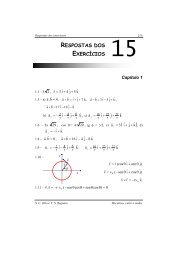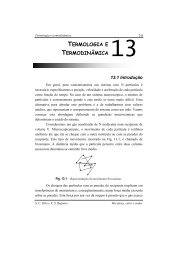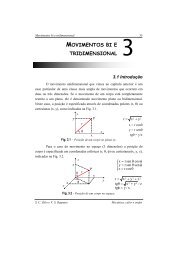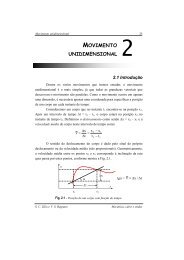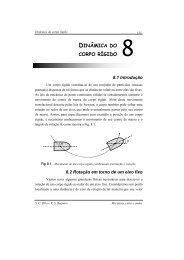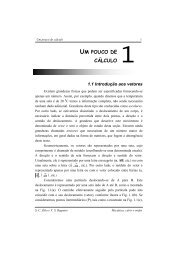Nonlinear Absorption Spectrum in Perylene Derivatives
Nonlinear Absorption Spectrum in Perylene Derivatives
Nonlinear Absorption Spectrum in Perylene Derivatives
You also want an ePaper? Increase the reach of your titles
YUMPU automatically turns print PDFs into web optimized ePapers that Google loves.
<strong>Nonl<strong>in</strong>ear</strong> <strong>Absorption</strong> <strong>Spectrum</strong> <strong>in</strong><br />
<strong>Perylene</strong> <strong>Derivatives</strong><br />
S. L. Oliveira, D. S. Corrêa, L. Misoguti, Misoguti,<br />
S. C. Zilio, Zilio,<br />
and C. R. Mendonça<br />
Instituto de Física de São Carlos-USP<br />
Carlos USP<br />
C.J.L. Constant<strong>in</strong>o<br />
Departamento de Física, Química e Biologia, FCT-UNESP,<br />
FCT UNESP, Brazil<br />
R.F. Aroca<br />
Materials and Surface Science Group, University of W<strong>in</strong>dsor, Canada
ABSTRACT<br />
Knowledge about nonl<strong>in</strong>ear absorption spectra of materials used <strong>in</strong><br />
photonic devices is of paramount importance <strong>in</strong> determ<strong>in</strong><strong>in</strong>g their optimum<br />
operation wavelengths. In this work, we have <strong>in</strong>vestigated the two-photon<br />
absorption (2PA) degenerate cross-section spectrum for perylene derivatives<br />
us<strong>in</strong>g the Z-scan technique with femtosecond laser pulses. All perylene<br />
derivatives studied present large 2PA cross-sections, only comparable to the<br />
best ones reported <strong>in</strong> the literature. The results achieved <strong>in</strong> the present<br />
<strong>in</strong>vestigation <strong>in</strong>dicate perylene derivatives as promis<strong>in</strong>g materials for twophoton<br />
applications.<br />
S. L. Oliveira, D. S. Correa, L. Misoguti, Misoguti,<br />
C. J. L. Constant<strong>in</strong>o, Constant<strong>in</strong>o,<br />
R. F. Aroca, Aroca,<br />
S. C. Zilio, Zilio,<br />
C. R. Mendonça, Mendonça,<br />
“<strong>Perylene</strong> “ <strong>Perylene</strong><br />
<strong>Derivatives</strong> with Large Two-photon Two photon <strong>Absorption</strong> Cross Sections for Application <strong>in</strong> Optical Limit<strong>in</strong>g Limit<strong>in</strong>g<br />
and Upconversion<br />
Las<strong>in</strong>g” Las<strong>in</strong>g”<br />
Advanced Materials, <strong>in</strong> press (2005).
TWO-PHOTON TWO PHOTON ABSORPTION<br />
Upon exposure to <strong>in</strong>tense laser pulses, molecules can <strong>in</strong>stantaneously <strong>in</strong>stantaneously<br />
absorb two photons to<br />
access an excited state, each of them with half of the energy required required<br />
to match the electronic<br />
transition.<br />
1-photon absorption<br />
(L<strong>in</strong>ear)<br />
2-photon absorption<br />
(<strong>Nonl<strong>in</strong>ear</strong>)<br />
r<br />
P = χ<br />
r<br />
(<br />
. E + χ<br />
r r<br />
(<br />
: EE<br />
+ χ<br />
r r r<br />
MEEE<br />
+ ...<br />
Such 2PA process has <strong>in</strong>terest<strong>in</strong>g characteristics, with direct consequence consequence<br />
for applications:<br />
(i) improved spatial resolution due to the square dependence on the excitation<br />
irradiance → 3D optical data storage, micro-fabrication;<br />
micro fabrication;<br />
(ii) negligible l<strong>in</strong>ear absorption at the pump<strong>in</strong>g wavelength, with with<br />
the result<strong>in</strong>g <strong>in</strong>crease of<br />
penetration depth → photodynamic cancer therapy<br />
( 1 )<br />
2 )<br />
[ ] ) 3 (<br />
Im χ<br />
α = α0<br />
+ β I<br />
3 )<br />
ββ: two-photon two photon absorption coefficient
TWO-PHOTON TWO PHOTON ABSORPTION SPECTRUM<br />
Accord<strong>in</strong>gly, a great deal of effort was directed to the development development<br />
of various design<br />
strategies employed to synthesize new two-photon two photon absorb<strong>in</strong>g materials with large 2PA<br />
cross-sections cross sections ( (δδ ) and <strong>in</strong>crease physical and chemical stability.<br />
High optical nonl<strong>in</strong>earities have been reported <strong>in</strong> organic materials materials<br />
at specific wavelengths,<br />
only recently the dispersion of the nonl<strong>in</strong>ear absorption over a wide spectral range started<br />
to be characterized. Such <strong>in</strong>formation is important:<br />
(i) Molecular design strategy of a given nonl<strong>in</strong>ear optical material material<br />
(ii) Orig<strong>in</strong> of the observed nonl<strong>in</strong>earities<br />
(iii) Operation wavelength for a given device<br />
2PA spectrum is obta<strong>in</strong>ed from:<br />
- Multi-photon Multi photon excited fluorescence<br />
- Open-aperture Open aperture Z-scan Z scan<br />
discrete wavelengths, tunable sources
OPEN-APERTURE<br />
OPEN APERTURE Z-SCAN SCAN<br />
( z)<br />
( z,<br />
0)<br />
∞<br />
∫<br />
−∞<br />
2<br />
− [ 1+<br />
q ( z,<br />
0)<br />
e ]<br />
T 1<br />
τ<br />
TN(<br />
z ) = = ln 0 dτ<br />
LT π q<br />
0<br />
Laser<br />
Normalized Transmitance<br />
1.00<br />
0.98<br />
0.96<br />
0.94<br />
0.92<br />
Normalized Transmittance:<br />
Know<strong>in</strong>g that<br />
0<br />
Sample<br />
0.90<br />
-10 -8 -6 -4 -2 0 2 4 6 8 10<br />
0<br />
( ) 1 2 2 −<br />
1+<br />
z /<br />
q ( z,<br />
t ) = βI<br />
( t ) L z<br />
z<br />
0<br />
Photodetector<br />
δ = hνβ N<br />
M. Sheik-Bahae et al., IEEE J. Quantum Electron. 26, 760-769 (1990).<br />
Trigger<br />
EXPERIMENTAL SETUP<br />
Clark-MXR<br />
Lock-<strong>in</strong><br />
Photodetector<br />
775 nm<br />
z = 0<br />
OPA<br />
Sample<br />
(Clark-MXR, CPA-2001)<br />
775 nm; 150 fs 0.8 mJ; 1kHz<br />
λ = 460-2600 nm<br />
Spatial Filter<br />
460-2600 nm; 120 fs; 20-60µJ<br />
(TOPAS, Quantronix)
In this context, the present work reports on the degenerate 2PA cross-section cross section spectra of<br />
perylene tetracarboxylic derivatives (PTCD) <strong>in</strong> the spectral range go<strong>in</strong>g from the visible<br />
to the near <strong>in</strong>frared.<br />
PTCD are organic dyes, readily available, thermal and chemically stable. The perylene<br />
moiety presents remarkable electron donor characteristics, although although<br />
add<strong>in</strong>g lateral<br />
groups the molecule could play the role of electron acceptor or donor. Moreover, their<br />
strong absorption and emission <strong>in</strong> the visible spectral range makes makes<br />
them potential<br />
candidates for applications as photoconductors, laser materials, etc.<br />
H11C5<br />
N<br />
C<br />
N<br />
N<br />
C<br />
C<br />
O O<br />
O<br />
C<br />
N<br />
C<br />
O<br />
MOLECULAR STRUCTURES<br />
N<br />
C<br />
N<br />
N N<br />
AzoPTCD Monothio BZP<br />
PazoPTCD<br />
N<br />
C<br />
N<br />
C<br />
O<br />
H9C4<br />
O<br />
O<br />
C<br />
N<br />
C<br />
O<br />
S<br />
BuPTCD<br />
N<br />
O<br />
O<br />
C<br />
N<br />
C<br />
O<br />
C4H9
σ abs (10 -16 cm 2 )<br />
6<br />
4<br />
2<br />
0<br />
4<br />
2<br />
0<br />
3<br />
2<br />
1<br />
0<br />
3<br />
2<br />
1<br />
TWO-PHOTON TWO PHOTON ABSORPTION CROSS-SECTION<br />
CROSS SECTION<br />
AzoPTCD<br />
BZP<br />
PazoPTCD<br />
BuPTCD<br />
12<br />
9<br />
6<br />
3<br />
0<br />
6<br />
0<br />
300 400 500 600 700 800<br />
0<br />
900 1000<br />
Wavelength (nm)<br />
4<br />
2<br />
0<br />
6<br />
4<br />
2<br />
0<br />
6<br />
4<br />
2<br />
δ (10 3 GM)<br />
FIG. 1. L<strong>in</strong>ear absorption and degenerate 2PA<br />
spectrum of the PTCD materials <strong>in</strong> a solution with<br />
10% trifluoroacetic acid <strong>in</strong> dichloromethane.<br />
- PTCD → l<strong>in</strong>ear absorption bands (400-660 (400 660 nm),<br />
with the vibronic structure superposed to the π-π* *<br />
transition.<br />
- High δ values at several excitation wavelengths.<br />
- The <strong>in</strong>crease observed <strong>in</strong> the 2PA cross-section<br />
cross section<br />
spectra → resonance enhancement of the<br />
nonl<strong>in</strong>earity ↔ sum-over sum over states (SOS) model,<br />
assum<strong>in</strong>g that the π→π* π→π transition gives the major<br />
contribution to the virtual <strong>in</strong>termediate state and<br />
that the excited state corresponds the absorption<br />
peaks around 350 nm.
FRONTIER MOLECULAR ORBITALS<br />
The molecular geometries were optimized by the AM1 method.<br />
Frontier molecular orbitals were calculated us<strong>in</strong>g ZINDO/S (HiperChem<br />
( HiperChem 7.5).<br />
Configuration <strong>in</strong>teraction (CI) calculations <strong>in</strong>cluded s<strong>in</strong>gle excited excited<br />
configurations from the<br />
ground state, 24 (occupied) x 24 (unoccupied)<br />
Transition energy (∆E ( l<strong>in</strong>ear.abs)<br />
l<strong>in</strong>ear.abs)<br />
decreases <strong>in</strong> a similar way as the π-conjugation conjugation length;<br />
Bathchromic shift are the result of the HOMO → LUMO energy change;<br />
By analyz<strong>in</strong>g the 2PA spectra far from l<strong>in</strong>ear absorption edge of the four PTCD derivatives<br />
it can be established an unambiguous relation between molecular charge delocalization<br />
(conjugation length) and the third-order third order nonl<strong>in</strong>ear optical response (2PA):<br />
The results suggest that even larger 2PA cross-sections cross sections could be obta<strong>in</strong>ed by<br />
manipulat<strong>in</strong>g the perylene derivatives, by position<strong>in</strong>g donor or acceptor groups<br />
symmetrically or by <strong>in</strong>creas<strong>in</strong>g the molecule conjugation length, length,<br />
<strong>in</strong> agreement with the<br />
molecular design strategies proposed <strong>in</strong> the literature.<br />
M. Albota, Albota,<br />
D. Beljone, Beljone,<br />
J. L. Breda, Breda,<br />
J. E. Ehrlich, J. Y. Fu, A. A. Heikal, Heikal,<br />
S. E. Hess, T. Kogej, Kogej,<br />
M. D. Lev<strong>in</strong>, S. Marder, Marder,<br />
D. McCord-Maughon<br />
McCord Maughon, ,<br />
J. W. Perry, H. Rockel, Rockel,<br />
M. Rumi, Rumi,<br />
G. Subramanian, W. W. Webb, X. L. Wu, C. Xu, Xu,<br />
Science 1998, 1998,<br />
281, 281,<br />
1653.
HOMO:<br />
LUMO:<br />
AzoPTCD
HOMO:<br />
LUMO:<br />
Monothio BZP
HOMO:<br />
LUMO:<br />
PazoPTCD
HOMO:<br />
LUMO:<br />
BuPTCD
OPTICAL LIMITING<br />
The result shows that PTCD compounds exhibit effective 2PA optical limit<strong>in</strong>g action,<br />
which is useful to limit very short pulses, pulses,<br />
especially at wavelengths near the l<strong>in</strong>ear<br />
absorption edge.<br />
E output (µJ)<br />
0.05<br />
0.04<br />
0.03<br />
0.02<br />
0.01<br />
0.00<br />
(a)<br />
0.3<br />
0.2<br />
AzoPTCD<br />
Monothio BZP<br />
PazoPTCD<br />
BuPTCD<br />
(b)<br />
Transmitância Normalizada<br />
1.0<br />
0.8<br />
0.6<br />
0.4<br />
0.2<br />
AzoPTCD<br />
monothio BZP<br />
0.0<br />
-1.0 -0.5 0.0<br />
x (cm)<br />
0.5 1.0<br />
0.00 0.03 0.06 0.09 0.12 0.15 0.18<br />
E <strong>in</strong>put (µJ)<br />
∆T<br />
0 5 10 15 20 25 30 35<br />
FIG. 2. (a) Output energy as a function of <strong>in</strong>put energy of AzoPTCD (10 18 molecules/cm 3 ) <strong>in</strong> a solution<br />
with 10% TFA <strong>in</strong> DCM and placed <strong>in</strong> a 2-mm 2 mm thick quartz cuvette for excitation wavelength at 770<br />
nm. The solid l<strong>in</strong>e represents the l<strong>in</strong>ear transmittance. The <strong>in</strong>set <strong>in</strong>set<br />
shows open-aperture open aperture Z-scan Z scan signatures<br />
for AzoPTCD and Monothio BZP; (b) Transmittance Transmittance<br />
change as a function of irradiance for PTCD<br />
derivatives<br />
0.1<br />
0.0<br />
Irradiance (GW/cm 2 )
Normalized Fluorescence<br />
2.0<br />
1.5<br />
1.0<br />
0.5<br />
UPCONVERSION EMISSION INDUCED BY 2PA<br />
A strong two-photon two photon excited fluorescent emission, which is a relevant prerequisite prerequisite<br />
for<br />
upconversion las<strong>in</strong>g, was measured <strong>in</strong> PTCD for excitation at 770 nm. It should should<br />
be po<strong>in</strong>ted<br />
out that the fluorescence is high enough to be seen by naked eyes. eyes.<br />
AzoPTCD<br />
Monothio BZP<br />
PAzo<br />
BuPTCD<br />
Intensity (arb. units)<br />
0.0<br />
510 540 570 600 630 660 690 720<br />
Wavelength (nm)<br />
10 1<br />
10 0<br />
FIG. 3. (a) Normalized two-photon two photon excited fluorescent emission of the PTCD compounds <strong>in</strong> a solution solution<br />
with 10% TFA <strong>in</strong> DCM pumped at 770 nm; (b) 2PA fluorescence <strong>in</strong>tensity <strong>in</strong>tensity<br />
vs. <strong>in</strong>cident energy.<br />
10 2<br />
10 1<br />
slope ~ 2<br />
(a) (b)<br />
10 2<br />
Incident power (µW)<br />
The observed emission <strong>in</strong>dicates the potential of PTCD to be used as active media for 2PP<br />
laser operat<strong>in</strong>g at short wavelengths. The he efficiency of 2PP las<strong>in</strong>g <strong>in</strong> dyes reported so far<br />
has been rather low (overall 2PP las<strong>in</strong>g efficiency smaller than 0.1).
CONCLUSIONS<br />
In summary, large 2PA cross-sections cross sections were measured, which are <strong>in</strong> the same order of the<br />
best ones reported for organic compounds specially designed for nonl<strong>in</strong>ear absorption. absorption.<br />
The<br />
results support that 2PA cross-section cross section can be improved by molecular design strategies and<br />
the resonance enhancement effect. It is expected that <strong>in</strong>creas<strong>in</strong>g the conjugation and/or<br />
add<strong>in</strong>g symmetric donor and acceptor species could further improve improve<br />
the 2PA effect. Results<br />
on the transmittance change versus excitation irradiance and the strong two-photon<br />
two photon<br />
<strong>in</strong>duced fluorescence demonstrate that PTCD compounds are attractive attractive<br />
for application <strong>in</strong><br />
optical limit<strong>in</strong>g and 2PP upconversion las<strong>in</strong>g.<br />
Acknowledgments



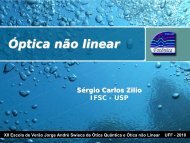
![Curso-Escola-JAS1.ppt [Modo de Compatibilidade] - Fotonica.ifsc ...](https://img.yumpu.com/21076978/1/190x135/curso-escola-jas1ppt-modo-de-compatibilidade-fotonicaifsc-.jpg?quality=85)
